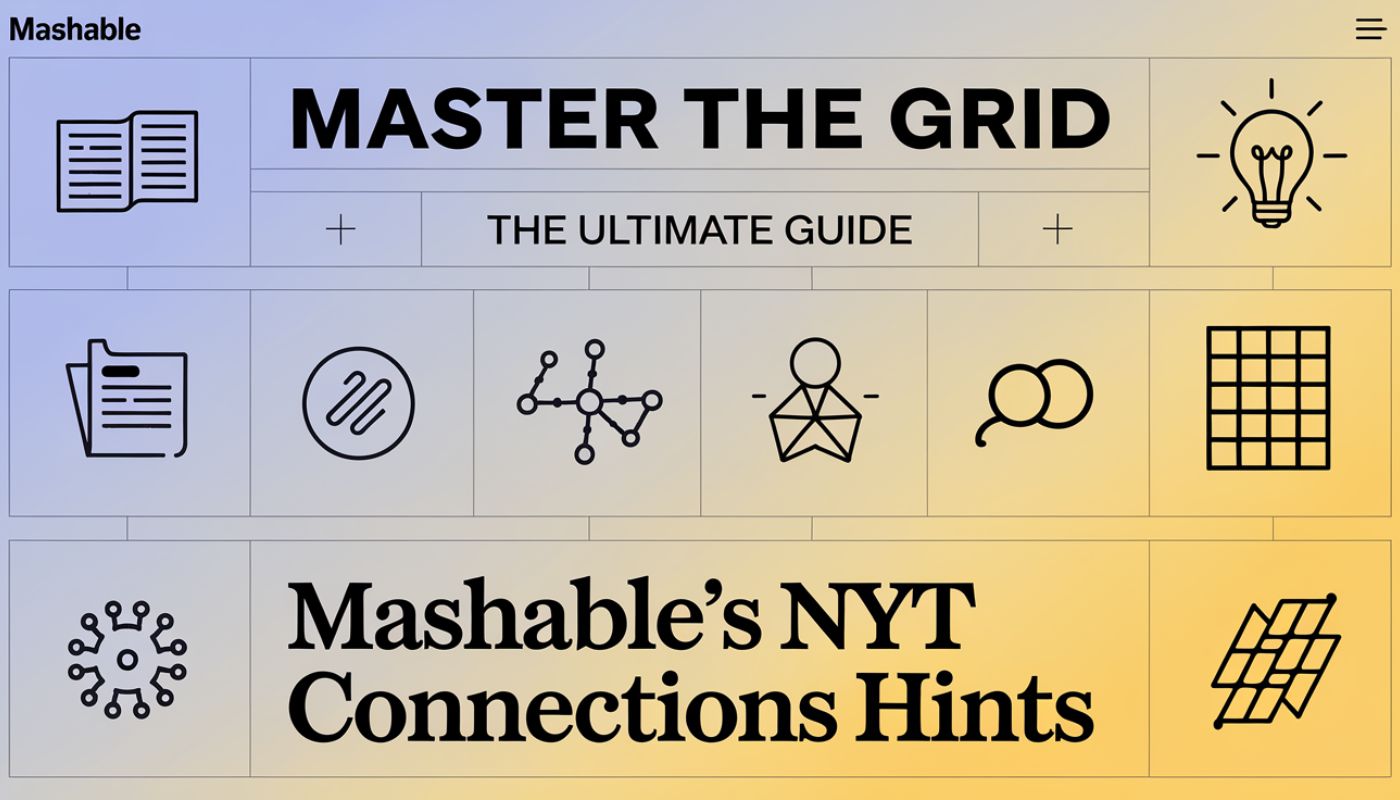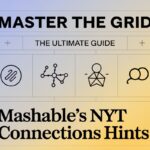So there I was, sitting cross-legged on my old creaky kitchen stool, half a cold coffee in hand, face squinting into the soft light of dawn — staring at sixteen innocent-looking words on a screen.
You’d think, at a glance, that these words were no big deal. Harmless. Simple. Some might even say… mundane? But in the daily NYT Connections puzzle, curated with precision by Wyna Liu, those words ain’t just words.
They’re traps. They’re riddles. They’re tiny semantic whirlpools that pull your brain into a place where “lemon,” “sour,” “green,” and “first date” might somehow be spiritually related.
And the wild part? I wasn’t alone. A quick scroll through r/NYTConnections or one of the booming Facebook groups (or god forbid, that one Twitter thread with spoilers in the first two replies 😤) tells you — this is a thing.
A daily ritual. A full-blown culture. And in the heart of it all? The unsung savior of the frustrated puzzler: Mashable’s Connections hints.
Let’s unravel this linguistic labyrinth together. No fluff. No fake cheerleading. Just honest help, strange thoughts, and a pinch of word-nerd joy.
Comprehensive Guide to Mashable and NYT Connections Hints
| Keyword | Answer |
|---|---|
| Mashable’s NYT Connections Hints | Mashable offers detailed, tiered hints to help players solve NYT Connections puzzles. |
| nyt connections mashable today | Today’s NYT Connections hints are available on Mashable shortly after the puzzle is released. |
| nyt connections hints | NYT provides basic hints, but sites like Mashable offer more in-depth and progressive clues. |
| connections hint today | You can get today’s Connections hint from Mashable or similar sites without full spoilers. |
| connections hint | A Connections hint typically gives a nudge toward the theme of each word group. |
| connections nyt | NYT Connections is a word puzzle where players group 16 words into four connected categories. |
| nyt connections hints forbes | Forbes occasionally covers Connections but is not a regular hint provider like Mashable. |
The Grid That Binds Us: Understanding NYT Connections
Before diving into hints and hacks, let’s just breathe in the weird brilliance of this game.
The Connections puzzle is a 4×4 word grid. You get 16 words, and your job is to group them into four categories of four. Each group shares some hidden link — could be a theme, a pun, a shared idiom, or something absurd like things that jiggle (yup, that was a real one. Still scarred).
Every group is color-coded based on difficulty:
- Yellow: Easy. The one you feel smart for spotting, but it was probably bait.
- Green: Still doable. Often the one your mom gets before you.
- Blue: Medium-hard. It has you scratching your scalp like you lost something in it.
- Purple: The Screamer. The misdirection master. The one that makes you text your friend in Iowa with “PLEASE tell me if ‘hook’ goes with ‘sink’ or ‘line’ or NOTHING?!”
It’s not just about knowledge — it’s pattern recognition, phonetic matching, idioms, lateral thinking, cognitive patterning, and the ability to spot red herrings from a mile away. Or not. Mostly not.
Meet Your Connections Coach: Why Mashable Hints Matter
If you’ve ever thrown your phone because “PAN” didn’t go with “POT,” you’ve probably Googled “Connections hints today” and landed on Mashable. And praise be — their hint system is tiered, non-condescending, and never gives away too much unless you want it.
Here’s why their style works:
- Progressive hinting: They start vague and get more specific. Great for mental calibration.
- Spoiler control: You choose how deep you wanna go — just a nudge? Or the full answer?
- Coaching tone: Feels more like a friend whispering over your shoulder than a teacher scolding from the front of the class.
Honestly? It’s like a gentle puzzle coach, not a cheat sheet. And the way they break it down builds your brain muscle over time. That’s that gamified learning effect — sneakily turning your morning rage into a cognitive flex.
Purple Group Meltdown Moments (And How to Survive Them)
Let’s talk Purple. Not just a color. A lifestyle. A trauma response. A cryptic corner of hell where you stare at words like Spade, Club, Heart, Diamond and tell yourself “They can’t possibly mean what I think they mean.” (Spoiler: they do.)
So here’s how you handle purple rage posts:
- Walk away. Seriously. Go pet your cat or stir some tea.
- Zoom out — don’t fixate. Look at the grid from a distance. Some folks use literal post-it notes.
- Use Mashable’s Purple hint — it’s usually cheeky, vague, and just enough to make your brain go click.
- Ask yourself “What could be a joke?” Purple loves humor, slang, or cultural overlap (especially from places like Kansas or Twitter-speak).
- Embrace misdirection. That’s the whole vibe. The category looks obvious, but it’s not. They want you to assume.
If you’re ever feeling defeated, remember: every Connectioner has had a Purple meltdown. It’s a rite of passage. Wear it like a badge, friend.
Read This Blog: https://blessloom.com/matt-kaplan-net-worth/
Wordle’s Cousin, But Weirder: Puzzle Culture & Daily Rituals
The rise of NYT Connections was quiet — no one thought it would ever rival Wordle. But then, slowly, silently, it became this daily obsession for a very specific kind of person. You know the type. Has bookmarks for Forbes, Reddit threads, and Puzzler’s Paradise. Thinks of “group of four” while watching Netflix subtitles.
And with that rise came rituals:
- Grandma in Kansas texting her “Green guesses” every morning before coffee.
- College kids in Iowa turning it into a pre-class tournament.
- People sliding into DMs to discuss “Blue group theories” like it’s true crime.
We’re not just solving puzzles. We’re forming communities, sharing wins and losses, and — dare I say it — becoming better thinkers.
Tips from the Grid Gurus: Lateral Thinking and Logic Jumps
Some hints you don’t get from articles — you get ‘em from experience. Or from that one guy on Reddit who solved it in 90 seconds and felt “disappointed”. (We get it, Jacob. You’re brilliant.)
Here’s what they don’t usually tell you:
- Always test categories in your head. Even when it feels right, check the leftovers. If what’s left makes no sense, your category might be wrong.
- Don’t chase the most obvious word. “BARK” could be dog, tree, or boat. That’s how they get ya.
- Color code in your mind. Try to guess what feels Yellow or Purple before solving. It trains your puzzle intuition.
- Say it out loud. Hearing words spoken can reveal phonetic patterns or idioms hidden to the eye.
- Trust weird gut feelings. Sometimes “Zipper” and “Seal” do belong together — because of sound, not sense.
Mashable hints can support your logic, but building your own mental models will make you a true grid wizard.
Social Solving: Reddit, Facebook, and the Age of Shared Confusion
Reddit threads, Facebook fan groups, and Mashable’s comments section aren’t just spoiler zones — they’re comfort zones. Puzzlers commiserate there. Post rage. Share Aha moments. Celebrate the rare “No Mistakes” badge.
Common behaviors:
- Sharing first guesses to laugh about how wrong they were.
- Live reactions to Purple group reveals.
- Comparing guesses with family members across timezones.
- Creating rituals like WordPlay Daily with friends.
Puzzle culture is collaborative. You’re not just solving — you’re syncing brains with strangers. And that? That’s a kind of intimacy the internet rarely creates.
How to Read Mashable’s Hints Like a Pro
You might think you’re just reading hints. But Mashable’s system is a language. Here’s how to interpret it like a native:
- “Think of things you might wear…” → The group will likely be clothes, accessories, or uniforms. Not literal.
- “These can all be said with a wink.” → Look for slang, innuendo, or double meaning words.
- “You’ll want to avoid these on a road trip.” → Could be weather, road signs, or moods. Think big picture.
Their writers are wordplay nerds too — they want you to get there on your own. So lean into the play.
Custom Hints: How to Coach Yourself Without Spoilers
Want to be your own Connections Coach?
- Create your own color hierarchy. Rank your guesses and label ‘em. Helps track patterns.
- Build a hint wall — list out themes without looking at the answer. Force your brain to find links.
- Ask guiding questions. Not “What do these words mean?” but “Where could I hear them used together?”
It’s interactive hint architecture at its best — training your brain like it’s in a linguistic gym.
Wrapping It Up: Words, Weirdness, and the Beauty of the Grid
Whether you’re a Wordle dropout or a NYT Connections junkie, the magic lives in the same place: that split second when confusion becomes clarity. When you shout “OH COME ON!” and also “Ohhh, come on…” — same phrase, different tone. That’s the puzzle euphoria.
Freqeuntly Asked Questions
connections nyt
NYT Connections is a daily word puzzle by The New York Times where players group 16 words into 4 connected categories.
nyt strands
NYT Strands is a newer word-search-style puzzle from The New York Times that involves finding themed words hidden in a letter grid.
connection hints today
You can find today’s Connections hints on sites like Mashable, offering gradual clues without full spoilers.
connections hint today
Today’s Connections hint is often shared in tiers—starting with vague categories and leading to specific word groupings.
strand nyt
Strand NYT refers to the Strands puzzle game launched by the New York Times, focused on thematic word discovery.
strands nyt
The NYT Strands puzzle challenges users to uncover words based on a hidden theme using a letter grid.
nyt connections hint
NYT’s official Connections hint gives a single clue for the puzzle’s overall theme, but it’s often cryptic and minimal.
new york times connections
New York Times Connections is a logic puzzle where users sort words into meaningful categories based on hidden relationships.
strands hint
A Strands hint typically reveals the main theme of the puzzle to help guide word discovery within the grid.
strands hints
Multiple Strands hints can be found online, offering help from basic theme reveals to word lists without full solutions.
connections answers today
Today’s Connections answers show the completed 4 word groups—usually available online after puzzle release time.
connections nyt hints
Connections NYT hints help players identify group themes and word patterns without giving away all the answers.
connection answers today
Today’s Connection answers are published daily on fan sites or blogs after the puzzle is released.
wordle hint today mashable
Mashable’s Wordle hint for today gives a clue about the five-letter word’s meaning or letter structure without spoiling it.
wordle hints today mashable
Mashable provides tiered Wordle hints—starting with subtle definitions and ending with spoiler-level clues if needed.
strands answers
Strands answers are the correct words hidden in the letter grid that fit the given theme for that day’s puzzle.
strands answer
The Strands answer refers to the final “Spangram” and other themed words needed to complete the day’s puzzle.
connections clues today
Today’s Connections clues are found in community forums and hint sites that guide players toward solving the categories.
nyt connection answers
NYT Connection answers are the grouped word solutions released after the puzzle expires or through fan-run pages.
strands hint today
Today’s Strands hint is the puzzle’s main theme clue, helping users identify related words hidden in the grid.











